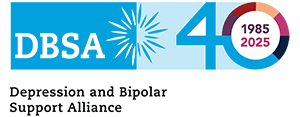The DBSA Young Adult Council (YAC) develops unique resources to support other young adults living with depression and bipolar. They use their own lived experience to help inform the way that DBSA provides hope, help, support, and education. In this piece, YAC member Hallin talks about experience with self-harm.
When I first learned about self-harm, I didn’t get it. I was in seventh or eighth grade, and besides some anxiety, I was living a stable, unmedicated life. The thought of someone hurting themselves on purpose seemed foreign and confusing.
Sophomore year in high school brought changes: my first relationship, new friendships, and more difficult classes. It was here that I first self-harmed. After arguing with two people close to me, I was plunged into an emotional whirlwind of the likes I had never known before. I felt suicidal for the first time in my life. I knew I couldn’t act on my suicidal thoughts, so I self-harmed instead. It was the first step on a long, difficult path.
I didn’t self-harm again for a while after that. It’s not that I didn’t think about it; I just didn’t feel obligated to do it. That changed a little over a year after my first instance. A new variable was added to the equation in January of my junior year of high school: mood swings. I was experiencing short periods of elation and longer periods of depression. In my depression, I went back to self-harm. I primarily self-harmed for two reasons: to gain control and to be heard. As my moods swung back and forth, I felt completely out of control in my own life. I looked for this sense of control I yearned for in self-harm. I also self-harmed to be heard. I felt like I was trapped in my own mind and screaming for someone to hear me. I thought maybe someone could if I hurt myself.
My self-harm paused after my junior year’s end due to an inpatient stay at a psychiatric hospital. This stay inspired me to try to stay away from self-harm and other damaging coping mechanisms. In the next year, I hardly self-harmed. There were a few instances, but they were sprinkled throughout the year sporadically. I thought about it often though, and the urges were difficult to resist. Everything ultimately escalated the summer before I entered college. I was extremely anxious and felt out of control in every way. I was destined for a new city, a new learning environment, and people I didn’t know. I was flat-out terrified. I was looking for something I could control, so I slipped back to self-harm. It started simply but persisted and worsened. I was in too deep now.
My self-harm continued in spurts over the next few months. I started doing it because I yearned for control. Then, I found myself doing it because I believed I deserved it. I thought I was a bad person in need of atonement, so I took this atonement into my own hands. My self-harm came to an end in January. It ended because I wanted to do better but also because I was scared. Those past few months had shown me not only how much damage I could do to myself but also how deep my self-loathing went. I had grown afraid of myself. Admittedly, I also was able to stop because I didn’t feel drawn to it anymore. My mood became more stable in January after another hospitalization, and I just didn’t feel self-harm was necessary anymore. A few months have passed, and I still have continued to refrain.
I owe a lot of my success to coping mechanisms I learned over the years and the people who taught me them. When I felt urges to self-harm, I looked at why I wanted to do it. I have found deep breathing, drawing/coloring, writing, and biking are great for me regardless of my situation. I have also found success with the TIPP skill and idea of distraction from dialectical behavioral therapy (DBT). TIPP stands for Temperature, Intense exercise, Paced breathing, and Progressive muscle relaxation. My favorite coping mechanisms under this skill are cold showers, biking or a power walk, and square breathing. The idea of distraction in DBT, which is present in the ACCEPTS skill, works to have you do another activity to take your mind off what’s distressing you. For example, when I’m feeling anxious or depressed, I really like taking a calming bubble bath with a lit candle to both calm me and take my mind off what’s wrong.
Additionally, the concepts presented in the Butterfly Project and the use of the I Am Sober app have been immensely helpful to me. The Butterfly Project asks someone struggling with self-harm to draw a butterfly on where they are likely to harm themselves and name it after a supporter or loved one. Then, the person attempts to not “kill” the butterfly with self-harm for as long as the butterfly lasts. Sometimes I can’t tell myself not to self-harm for myself. That doesn’t hold enough weight in my mind. In these moments, having something like a butterfly to give me a reason to hold back is helpful. Keeping track of my progress with the I Am Sober app has also helped me. When I was having constant urges to self-harm, I always made sure to make a pledge on the app in the morning and review it in the evening. While I don’t check the app every day anymore like I used to, I do still have notifications on and enjoy celebrating each “milestone.” I know my progress isn’t measured only in the number of days since I’ve last self-harmed, but it still feels nice to get a little celebratory message about how long it’s been every once in a while.
I haven’t had the longest journey with self-harm, yet I’ve learned so much from it. Self-harm is not a kind act, but my self-harm has come with lessons. I have learned I don’t need to be in control, and I’ve never been a bad person. Life is a series of events we often can’t control. While it may be difficult, I have learned that sometimes I must yield to the forces of the universe. I also may be a person who has done bad things, but that doesn’t make me a bad person. And even if I was a bad person, I don’t believe I should be the one atoning myself.
I’ve learned the damage self-harm can do is not always just physical. To me, self-harm is more than just the physical act itself. It’s also the urges, the thoughts behind these urges, and the memories associated with all of them, which are not always visible. For me, the physical damage that self-harm caused me is minimal compared to the psychological damage it caused. I always remind myself to be kind and thoughtful towards myself and others who struggle. I never know how much damage of any kind has been caused by a person’s self-harm act(s).
I’ve also learned that I’m not alone and should reach out for help. Although I believe that often few, if any, people in my life truly understood the depths of my self-harm, they didn’t need to. They cared for me whether they understood it or not, and they wanted to help me when I struggled. That’s what matters.
Finally, I learned that it’s okay to relapse. As the saying goes, progress isn’t linear. I believe it’s true. It has always been a few steps forward and a few steps back for me. But I don’t fault myself for a relapse either. Self-harm is hard to break away from, and sometimes doing my best means doing the least damage possible, not doing no damage at all.
Please note, DBSA does not endorse any specific mobile apps or treatment.


